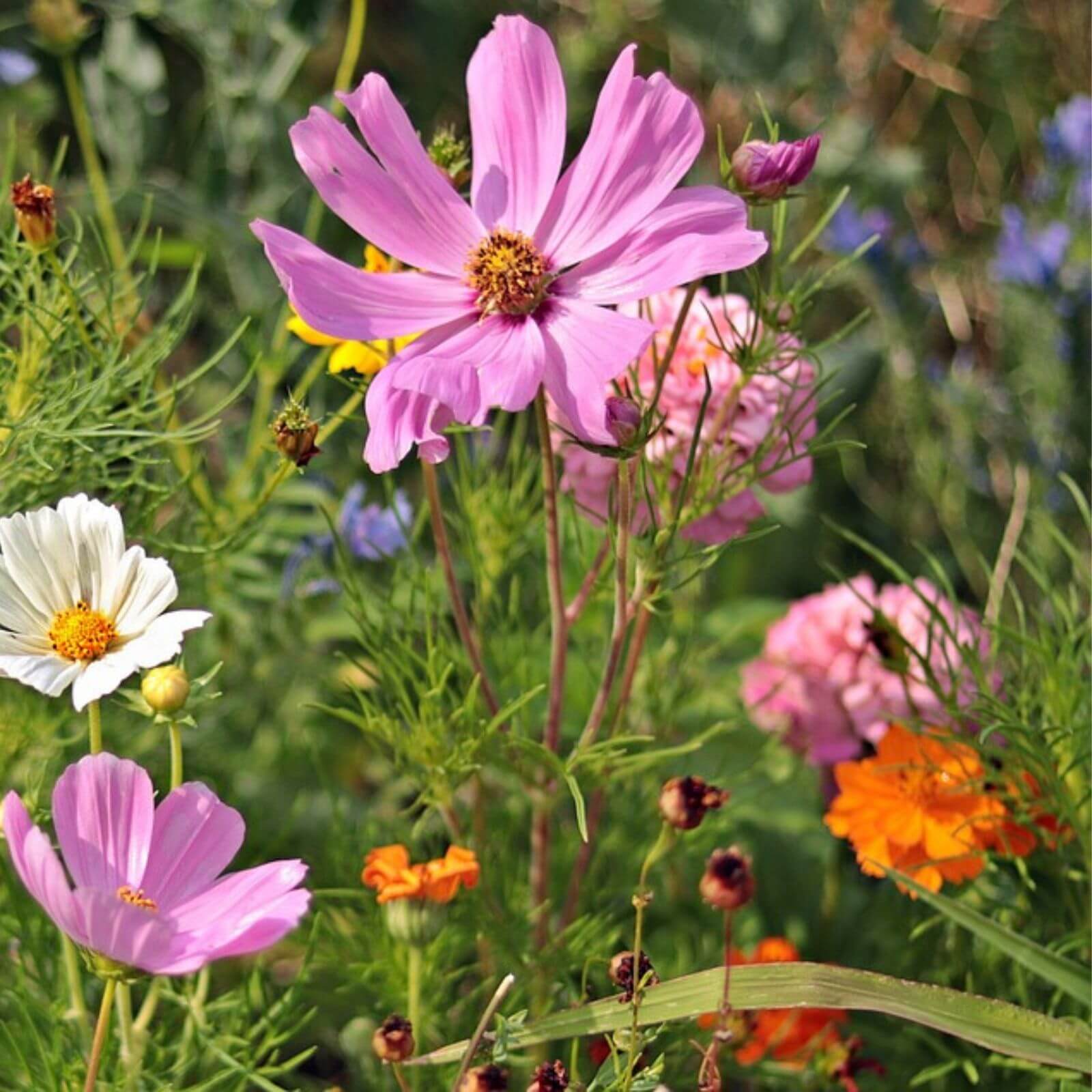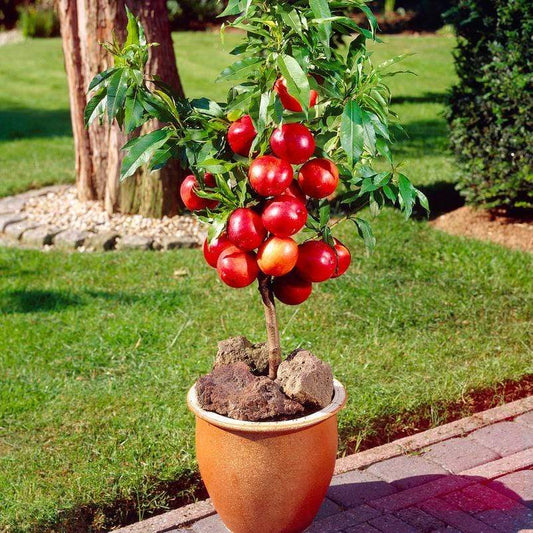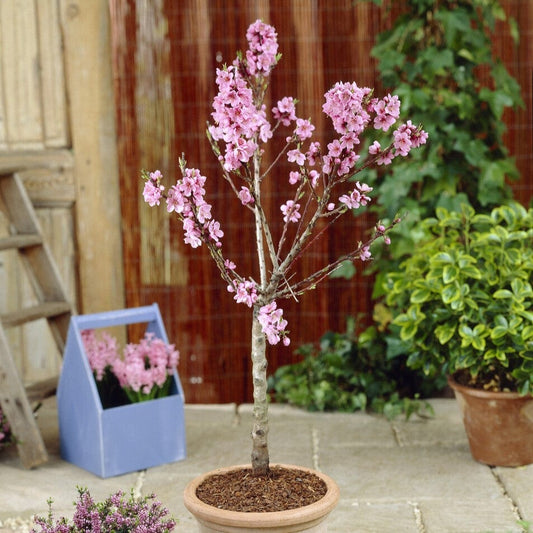How to Grow Peaches in the UK

Growing peaches in the UK? Yes, that’s a thing! Once the preserve (sorry) of sunnier climes or hothouses, new, hardier breeds of peach and nectarine tree mean that you can enjoy a freshly picked homegrown peach wherever you live.
It’s not as straightforward as growing an apple or a pear tree, granted, but with a bit of care and a few helpful pointers from our growers, this will be a very rewarding project! Here’s all you need to know…
Jump to:
- Where do peaches grow?
- Growing peach trees from seed
- Growing peach trees from a plant
- How much water do peach trees need?
- Do peach trees need feeding?
- Do peach trees self-pollinate?
- Can peach trees be grown in pots?
- Peach tree pruning
- Peach tree training
- Peach tree problems
- Caring for peach trees in winter
- Harvesting peaches
- How long do peaches keep?
Where do peaches grow?
Peaches are originally from China, and have been cultivated there since Neolithic times. They’re said to have been brought to Europe by Alexander the Great, via Persia (now Iran) which is where they picked up their botanical name, Prunus persica.
It took until the 17th century for peaches to be cultivated in the UK, but they didn’t become widely grown here until two hundred years later, and most of the peaches we eat today are still imported.
I think that’s a bit of a shame, as thanks to the efforts of fruit tree breeders, anyone can now grow their own peach or nectarine tree. You’ll need a really sunny position for your peach tree or the fruit won’t ripen, but there are plenty of suitable places for them, including south-facing walls, greenhouses, polytunnels and conservatories.
If you’re in one of the colder parts of the UK you can still get great results by growing your peach tree in a pot and bringing it indoors over winter.

How to grow a peach tree from seed
Full disclosure, growing a tree from a peach seed (AKA pit or stone) is a long process, but so satisfying if it comes to fruition! Here’s how.
Firstly, try to get a stone from a peach that’s been grown in the UK. A shop bought peach will have been imported from a warmer country and the resulting tree might not be hardy enough to survive the UK weather.
It’s also best to start off a few peach stones at the same time as it’s likely that not all of them will germinate. Once you’ve eaten the peaches, remove the stones, wash off any remaining flesh and leave them to dry for a couple of weeks.
Peach seeds need to be stratified (the process where they go through a cold spell before they can germinate) so the next step is to put them in a bag in the fridge with some damp sand or wrapped in a damp kitchen towel. Leave them there for about eight weeks, then it’s time to plant!
Prepare a pot for each peach seed, filled with garden soil or compost. Lie the seed on its side and cover it with a little more soil before giving it a good watering. Keep your pots in a warm, sheltered spot and water them when needed – you should see shoots in a few weeks. When your new trees have grown a few sets of leaves, you can harden them off and plant them outdoors or pot them on.
A peach tree typically takes around three years to start producing blossom and fruit. Trees grown from seed may not end up producing the same variety of peaches as their parent tree, but it can be fun to see what develops!

How to grow a peach tree from a plant
If you can’t wait three years for your peaches, you’re best off buying a young tree which has been grown on the nursery for a couple of years already. This means that by the time it goes in your garden, you’re likely to see blossom by the following spring and fruit not long after.
Starting with a UK-grown, grafted tree also ensures that it will be hardy enough for your garden and will grow true to the variety you choose. Peach and nectarine trees are available in bare root or potted form: what’s the difference?
Planting a bare root peach tree
Bare root trees are available from November to March each year, when they’re in their dormant season. It’s a good way to save money on trees – they’re sent to you without a pot or compost – and the choice of varieties also tends to be better.
To plant your bare root tree, first soak the roots in a bucket of water for up to an hour, then provided that the ground is warm and workable, you’re good to go ahead and plant it as below.
Planting a potted peach tree
The advantage of potted trees is that they’re available to buy and plant all year round. Simply wait for a dry day when the temperature isn’t too low and dig a hole large enough for your tree’s roots to spread out.
Carefully position the tree in the centre and fill the hole in with soil, adding some compost or manure as you go, for a nutrient boost. Firm down the soil around your peach tree and give it a good bucket of water. Adding a layer of mulch can also help your young tree, by keeping the moisture in the soil and the weeds out.
You can plant along with our tree grower, John, in this easy-to-follow video guide.

How much water do peach trees need?
Water your new peach tree regularly for the first year or so, to help it develop a good root system. Once this is established, it’ll be fine most of the year and you’ll only need to water your tree during hot or dry weather. The exceptions to this are peach trees grown in pots – the soil in containers dries out more quickly than that on the ground – and those grown next to a wall.
Planting a peach tree by a wall is a good move, as it’ll be sheltered from strong winds and will absorb heat from it. It does, however, create a bit of a rain gap, with drier soil than usual, so you should check often and water to keep the soil consistently moist. When your peaches start to ripen, it’s important to avoid overwatering, as this can cause the fruit to split.

Do you have to feed peach trees?
Peach trees aren’t heavy feeders – once a year in late winter or early spring is sufficient, when a nitrogen-rich feed will help the new blossom and fruit to develop. While you’re at it, give your tree a new layer of mulch at the same time each year, to help renew the nutrients in the surrounding soil.

Are peach trees self-pollinating?
All of our peach and nectarine trees are self fertile, meaning that they have both male and female flowers and can produce a crop without another tree to pollinate them. Having said that, there are a few ways you can help your tree produce more flowers and fruit.
Planting another peach tree isn’t necessary but will increase the size of both trees’ crops when they cross pollinate. As peaches and nectarines flower quite early in the spring, this does present a couple of challenges. Firstly, if there’s a late frost when the trees are in flower, there’s the risk that the blossom could be damaged and no fruit will be produced – see below for winter protection tips.
Secondly, there just aren’t as many pollinating insects around early in the spring, so it’s a good idea to give them a hand and pollinate some flowers yourself. To do this, use a soft paint brush, wet it slightly and press the bristles into the centre of each flower in turn, making sure that pollen is transferred between each one. If you do this for several days in a row (dry, sunny days are best) you can really make a difference to your tree’s productivity.

Can you grow a peach tree in a pot?
Peach and nectarine trees can certainly be grown in containers: choose a dwarf or semi-dwarf variety for the best results, such as those grown on Montclare rootstock, which grow to a maximum height of 3m and can be pruned smaller to fit any space.
The advantage of growing in a pot is that you can move your tree around to catch the sun and even bring it indoors in winter. They do need a little more care to keep them healthy and happy; check the soil regularly and water often, then repot your tree every two to three years with fresh compost and cover the top of the soil with mulch.

Pruning peach trees
The right time to prune your peach tree is in the spring, just when the new growth is starting. Encouraging your tree to grow in a well-shaped form with good airflow through the branches will help to prevent diseases and allow plenty of sunlight to reach the fruit, so what you should be aiming for is an open, goblet-shaped framework.
First of all, remove any dead, damaged or crossing branches completely, then cut back any older branches that have stopped fruiting, to a healthy new shoot, leaving plenty of space for the new stems to grow.

Can you train a peach tree?
Training fruit trees isn’t just for show offs (although no judgement here, they’re pretty impressive after all), it can help your tree to be more healthy and productive, ward off disease and save valuable garden space.
Peach and nectarines are suitable for fan and espalier training (against a wall) or half-standard training (as a neat, lollipop-shaped tree). You can find out more about these training methods and how to do them in our fruit tree training guide.

Peach tree problems
Keep an eye out for these pests and diseases that sometimes affect peach trees – catching them early will stop them becoming a serious problem, and prevention is even better!
Peach leaf curl
This is a fungal disease which can affect the newly emerging leaves in spring, distorting them and making them curl up. They might also develop a white fungal bloom before dropping off.
The good news is that you can choose a variety with built in peach curl resistance, such as Avalon Pride. Protecting your tree from any predicted frosts between November and April (see below) will also help to prevent peach leaf curl setting in.
Bacterial canker
If your tree develops canker, you’ll see sunken, dead patches of wood (sometimes oozing gum) and ‘shot’ holes in the leaves. If left untreated, whole branches can die, but you can often stop canker in its tracks by cutting out all affected parts as soon as it’s spotted. Dispose of these in the landfill bin or by burning, and disinfect your pruning tools, to avoid spreading the disease.
Blossom wilt
Any fruit tree can fall foul of blossom rot, which makes their flowers turn brown, shrivel and develop brown pustules of fungus. Again, this is best caught early and dealt with by pruning out all of the affected parts of the tree.
Aphids
Like all plants, peach trees can be affected by aphids (AKA greenfly/blackfly). These sap-sucking insects can be left alone if the population is quite small, but if it’s got to Biblical plague proportions, this can weaken the tree.
To get rid of aphids, you can spray the affected areas with a home made soap and vegetable oil spray or blast them with a hosepipe, but the most effective way is to encourage predators like ladybirds. Ladybirds love plants like tansy, fennel, marigolds and achillea, so planting these nearby or under the tree is a good call!
Scale insects
There are many kinds of sap-loving scale insects, but on a peach tree you should look out for little brown flat bugs, about 3-6mm long, on the woody parts of the plant. Like the aphids, they can weaken your tree and attract mould by secreting a sticky substance.
Encouraging predators (ladybirds, lacewings and hoverflies) often works, as does spraying them off, but if all that fails, nematodes are a good way to get rid of them – the ones you want are Steinernema feltiae.
Squirrels and pigeons and wasps, oh my!
The problem with peaches is that they’re too damn tasty. If you’re losing your carefully nurtured fruit to the local wildlife, there are some measures you can take to protect it.
If you save those little organza bags you get jewellery, gifts or wedding favours in, these can be tied over the developing fruit to keep wasps off. Alternatively, you can try netting your tree or getting a motion-activated sprinkler to deter the larger pests.
Read about more fruit tree problems and how to solve them.

How to care for peach trees in winter
If you live in a warmer part of the UK or you’re growing your peach tree under cover, you probably don’t need to worry about the winter weather. The rest of us, however, will need to be a little more vigilant. The trees themselves are perfectly hardy – it’s the blossom that doesn’t fare too well in cold conditions.
Produced early in spring, it’s vulnerable to frost and will need protection if you’re to get any fruit developing. Keep an eye on the forecast and get ready to leap into action if there's frost predicted, wrapping any outdoor grown trees in horticultural fleece (or bubble wrap) overnight. Don’t forget to remove it when the weather warms up though – those bees need to get to work!

Harvesting peaches
Although you may have to wait a year or so for your peach tree to produce fruit, this will increase year on year, with a mature tree able to produce up to 20kg of peaches. To harvest your peaches, wait until they’re fully coloured and the flesh nearest the stalk feels soft.
Hold the peach in the palm of your hand and gently lift it off the branch – it should come away easily if it’s ready. Your peaches will ripen one by one in their own sweet time, so keep checking the tree every day or so.

How long do peaches keep?
Peaches are best eaten straight away (I mean who can resist?) but if you do get a mega harvest, there are ways and means to make sure no peach gets left behind. Fresh peaches will keep on the kitchen counter for one or two days or in the fridge for up to a week. After that, your best options for peach preservation are bottling, drying or making a batch of jam.
A fairly low effort method is freezing, but you’ll have to stone and slice the peaches first. Lay your slices on a baking sheet and freeze them for a couple of hours (this stops them melding into a giant peach mass), then you can transfer them to a freezer bag or storage box. This is a particularly good way of making sure you have peach crumble all year round.
Excited to give it a go? Choose the best peach tree for your garden with our growers’ guide.
Last updated: 26/06/2024




















